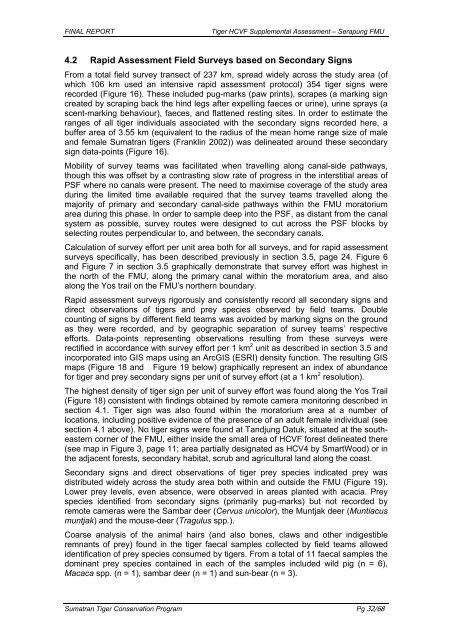A Supplemental HCVF Assessment on the Sumatran Tiger ...
A Supplemental HCVF Assessment on the Sumatran Tiger ...
A Supplemental HCVF Assessment on the Sumatran Tiger ...
You also want an ePaper? Increase the reach of your titles
YUMPU automatically turns print PDFs into web optimized ePapers that Google loves.
FINAL REPORT <strong>Tiger</strong> <str<strong>on</strong>g>HCVF</str<strong>on</strong>g> <str<strong>on</strong>g>Supplemental</str<strong>on</strong>g> <str<strong>on</strong>g>Assessment</str<strong>on</strong>g> – Serapung FMU<br />
4.2 Rapid <str<strong>on</strong>g>Assessment</str<strong>on</strong>g> Field Surveys based <strong>on</strong> Sec<strong>on</strong>dary Signs<br />
From a total field survey transect of 237 km, spread widely across <strong>the</strong> study area (of<br />
which 106 km used an intensive rapid assessment protocol) 354 tiger signs were<br />
recorded (Figure 16). These included pug-marks (paw prints), scrapes (a marking sign<br />
created by scraping back <strong>the</strong> hind legs after expelling faeces or urine), urine sprays (a<br />
scent-marking behaviour), faeces, and flattened resting sites. In order to estimate <strong>the</strong><br />
ranges of all tiger individuals associated with <strong>the</strong> sec<strong>on</strong>dary signs recorded here, a<br />
buffer area of 3.55 km (equivalent to <strong>the</strong> radius of <strong>the</strong> mean home range size of male<br />
and female <strong>Sumatran</strong> tigers (Franklin 2002)) was delineated around <strong>the</strong>se sec<strong>on</strong>dary<br />
sign data-points (Figure 16).<br />
Mobility of survey teams was facilitated when travelling al<strong>on</strong>g canal-side pathways,<br />
though this was offset by a c<strong>on</strong>trasting slow rate of progress in <strong>the</strong> interstitial areas of<br />
PSF where no canals were present. The need to maximise coverage of <strong>the</strong> study area<br />
during <strong>the</strong> limited time available required that <strong>the</strong> survey teams travelled al<strong>on</strong>g <strong>the</strong><br />
majority of primary and sec<strong>on</strong>dary canal-side pathways within <strong>the</strong> FMU moratorium<br />
area during this phase. In order to sample deep into <strong>the</strong> PSF, as distant from <strong>the</strong> canal<br />
system as possible, survey routes were designed to cut across <strong>the</strong> PSF blocks by<br />
selecting routes perpendicular to, and between, <strong>the</strong> sec<strong>on</strong>dary canals.<br />
Calculati<strong>on</strong> of survey effort per unit area both for all surveys, and for rapid assessment<br />
surveys specifically, has been described previously in secti<strong>on</strong> 3.5, page 24. Figure 6<br />
and Figure 7 in secti<strong>on</strong> 3.5 graphically dem<strong>on</strong>strate that survey effort was highest in<br />
<strong>the</strong> north of <strong>the</strong> FMU, al<strong>on</strong>g <strong>the</strong> primary canal within <strong>the</strong> moratorium area, and also<br />
al<strong>on</strong>g <strong>the</strong> Yos trail <strong>on</strong> <strong>the</strong> FMU’s nor<strong>the</strong>rn boundary.<br />
Rapid assessment surveys rigorously and c<strong>on</strong>sistently record all sec<strong>on</strong>dary signs and<br />
direct observati<strong>on</strong>s of tigers and prey species observed by field teams. Double<br />
counting of signs by different field teams was avoided by marking signs <strong>on</strong> <strong>the</strong> ground<br />
as <strong>the</strong>y were recorded, and by geographic separati<strong>on</strong> of survey teams’ respective<br />
efforts. Data-points representing observati<strong>on</strong>s resulting from <strong>the</strong>se surveys were<br />
rectified in accordance with survey effort per 1 km 2 unit as described in secti<strong>on</strong> 3.5 and<br />
incorporated into GIS maps using an ArcGIS (ESRI) density functi<strong>on</strong>. The resulting GIS<br />
maps (Figure 18 and Figure 19 below) graphically represent an index of abundance<br />
for tiger and prey sec<strong>on</strong>dary signs per unit of survey effort (at a 1 km 2 resoluti<strong>on</strong>).<br />
The highest density of tiger sign per unit of survey effort was found al<strong>on</strong>g <strong>the</strong> Yos Trail<br />
(Figure 18) c<strong>on</strong>sistent with findings obtained by remote camera m<strong>on</strong>itoring described in<br />
secti<strong>on</strong> 4.1. <strong>Tiger</strong> sign was also found within <strong>the</strong> moratorium area at a number of<br />
locati<strong>on</strong>s, including positive evidence of <strong>the</strong> presence of an adult female individual (see<br />
secti<strong>on</strong> 4.1 above). No tiger signs were found at Tandjung Datuk, situated at <strong>the</strong> sou<strong>the</strong>astern<br />
corner of <strong>the</strong> FMU, ei<strong>the</strong>r inside <strong>the</strong> small area of <str<strong>on</strong>g>HCVF</str<strong>on</strong>g> forest delineated <strong>the</strong>re<br />
(see map in Figure 3, page 11; area partially designated as HCV4 by SmartWood) or in<br />
<strong>the</strong> adjacent forests, sec<strong>on</strong>dary habitat, scrub and agricultural land al<strong>on</strong>g <strong>the</strong> coast.<br />
Sec<strong>on</strong>dary signs and direct observati<strong>on</strong>s of tiger prey species indicated prey was<br />
distributed widely across <strong>the</strong> study area both within and outside <strong>the</strong> FMU (Figure 19).<br />
Lower prey levels, even absence, were observed in areas planted with acacia. Prey<br />
species identified from sec<strong>on</strong>dary signs (primarily pug-marks) but not recorded by<br />
remote cameras were <strong>the</strong> Sambar deer (Cervus unicolor), <strong>the</strong> Muntjak deer (Muntiacus<br />
muntjak) and <strong>the</strong> mouse-deer (Tragulus spp.).<br />
Coarse analysis of <strong>the</strong> animal hairs (and also b<strong>on</strong>es, claws and o<strong>the</strong>r indigestible<br />
remnants of prey) found in <strong>the</strong> tiger faecal samples collected by field teams allowed<br />
identificati<strong>on</strong> of prey species c<strong>on</strong>sumed by tigers. From a total of 11 faecal samples <strong>the</strong><br />
dominant prey species c<strong>on</strong>tained in each of <strong>the</strong> samples included wild pig (n = 6),<br />
Macaca spp. (n = 1), sambar deer (n = 1) and sun-bear (n = 3).<br />
<strong>Sumatran</strong> <strong>Tiger</strong> C<strong>on</strong>servati<strong>on</strong> Program Pg 32/68

















